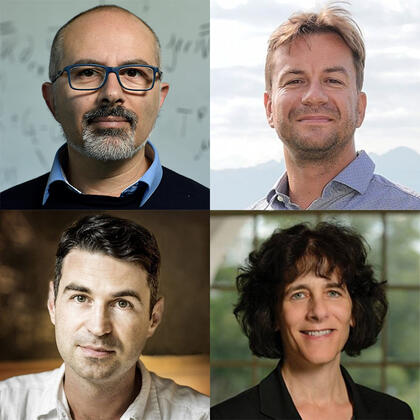Four faculty members from Johns Hopkins University's Krieger School of Arts and Sciences were recently named part of large-scale, multi-institutional collaborations funded by the Simons Foundation, highly competitive projects designed to bring together groups of scientists to address topics of fundamental scientific importance in which a significant new development has created a novel area for exploration in an established field.

Image caption: Clockwise from top left: Emanuele Berti, Matthieu Wyart, Cynthia Moss, and Brice Ménard
In bringing together teams of co-PIs, Simons collaborations grants facilitate large-scale longitudinal studies typically not possible under conventional grants. They provide postdoctoral and doctoral student support, support for travel and meetings, and the ability to enlist the expertise of associates from co-PI institutions and elsewhere.
The Hopkins faculty involved in the collaborations are:
Emanuele Berti, professor in the Department of Physics and Astronomy, who will be one of 12 co-PIs on the Simons Collaboration on Black Holes and Strong Gravity. Over the course of the four-year grant, the researchers will work to develop a theoretical framework for understanding what gravitational wave data can reveal about some of the universe's enduring mysteries.
Brice Ménard, a professor in the Department of Physics and Astronomy, and Matthieu Wyart, a research professor in the same department, who will be part of the four-year Collaboration on the Physics of Learning and Neural Computation. The team of 22 co-PIs aims to establish a new field of science—the physics of learning—at the intersection of physics, mathematics, and computer science.
Cynthia Moss, professor in the Department of Psychological and Brain Sciences, who is co-PI in the Collaboration on Ecological Neuroscience, a 10-year program designed to discover the neural underpinnings of natural behaviors across species.
Another Simons collaboration, Learning the Universe, which began in 2021, was renewed for three years. The renewal brings Johns Hopkins into this collaboration as one of the co-PIs, Benjamin Wandelt, recently joined the university as research professor in the Department of Physics and Astronomy. Collaborators use a Bayesian forward modeling approach to infer the universe's initial conditions and the physical laws that govern its evolution.
More on the collaborations:
Collaboration on Black Holes and Strong Gravity
A new era in gravitational observations provides an opportunity to deepen our understanding of strong gravity, which in Einstein's theory of general relativity is understood as the curvature of spacetime. The collaboration will focus on black holes, compact objects whose strong gravity prevents everything—even light—from escaping their interior. When black holes collide, they generate vibrations in spacetime, called gravitational waves, that were first predicted by Einstein. Researchers now have the ability to "listen" to these vibrations of spacetime and decode the secrets about the universe that they carry.
Through a multidisciplinary effort spanning theoretical physics, mathematics, numerical computation, AI-assisted data analysis, and gravitational wave observation, the collaboration aims to shed light on the matter-antimatter asymmetry of the universe, the nature of dark matter, and new physics beyond Einstein's theory of general relativity.
"The research by the collaboration is particularly important in this moment because it is designed to optimize the science return of the LIGO-Virgo-KAGRA collaboration, while also planning for similar future experiments that should be operational in about a decade (the Einstein Telescope in Europe, Cosmic Explorer in the U.S., and the space-based detector LISA)," Berti said. "It's exciting because it brings together leading researchers in a broad range of disciplines to advance our understanding of gravity—the dominant force at large scales in the universe—and of black holes. It is unique in its synergy between pure theory and experiment, and it would be most exciting if experiments were to give us hints that our current (incomplete) understanding of gravity and black holes needs revision."
Collaboration on the Physics of Learning and Neural Computation
Recent rapid advances in AI are already ushering in significant shifts in our economy, our society, and even the nature of scientific research. Moving far more slowly is our scientific understanding of this progress in AI capabilities. AI is often perceived as a black box that is meant to be improved through trial and error, but not to be understood. While computer science has already advanced our understanding of learning, this program will bring essential concepts and methodology from physics and math into the equation, allowing the researchers to study AI as a complex system. This will help explain fundamental principles of learning and computation and break AI out of its black box, with implications for academia, industry, and society at large.
"AI is being deployed all around us. It is critical to study its theoretical foundations to understand its full potential and limitations," Ménard said.
Collaboration on Ecological Neuroscience
As we perceive the world around us, we make decisions about how to move our bodies. But neuroscience has not yet fully explained how the brain integrates sensory and motor information to make those decisions efficiently. This program will use an interdisciplinary approach to test the hypothesis that the brain links perception with action by encoding "affordances"—opportunities for action available in the environment (for example, a chair affords the opportunity to sit). Spanning theory and data science as well as brain modeling in species ranging from rodents and bats to humans and primates, the 20 co-PIs aim to bridge gaps in our understanding of cognition by identifying how the brain represents these sensorimotor interactions and uses that information.
"This research project presents an extraordinary opportunity for scientific advances by integrating theory, data science, and coordinated neuroscience experiments in diverse species," Moss said. "To my knowledge, no one has tried such an ambitious project as this, taking the framework of affordances and testing it rigorously across brain areas and across species. Having contributions from data scientists and theoreticians, which will help us better understand our data, will be transformative and enable amazing breakthroughs."






